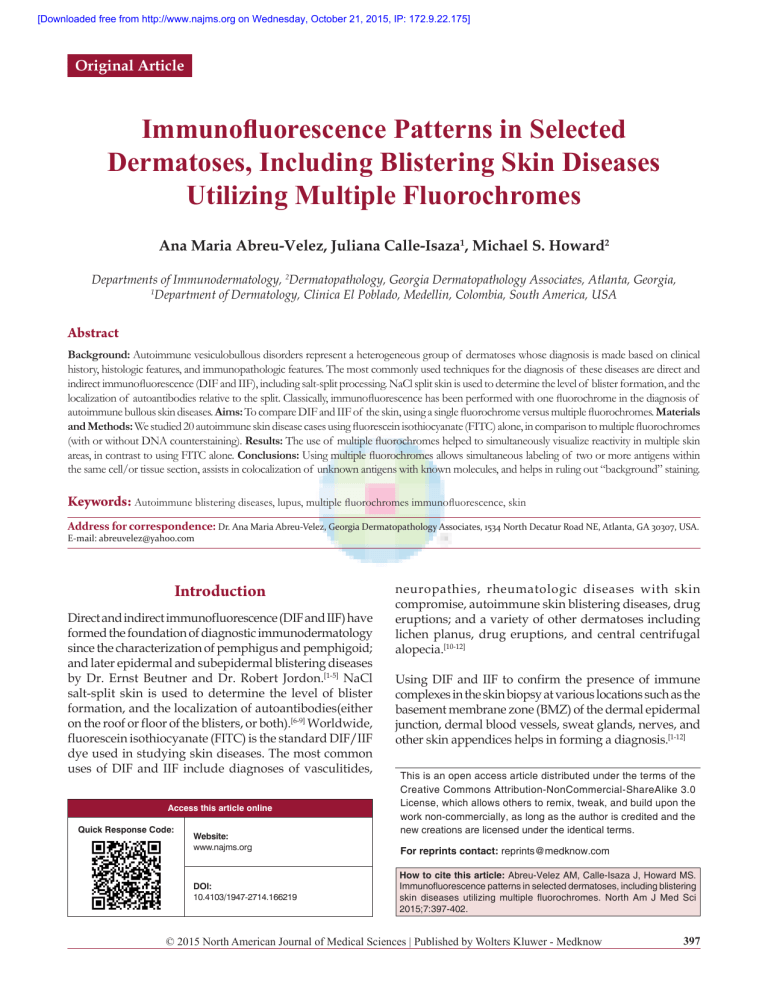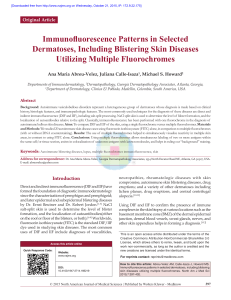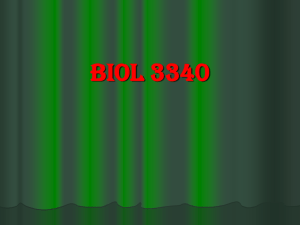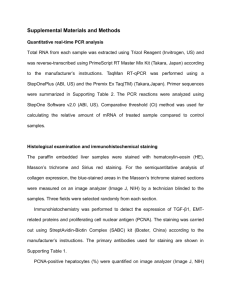Fluorochrome PDFNorthAmJMedSci79397-328654 090745
advertisement

[Downloaded free from http://www.najms.org on Wednesday, October 21, 2015, IP: 172.9.22.175] Original Article Immunofluorescence Patterns in Selected Dermatoses, Including Blistering Skin Diseases Utilizing Multiple Fluorochromes Ana Maria Abreu-Velez, Juliana Calle-Isaza1, Michael S. Howard2 Departments of Immunodermatology, 2Dermatopathology, Georgia Dermatopathology Associates, Atlanta, Georgia, 1 Department of Dermatology, Clinica El Poblado, Medellin, Colombia, South America, USA Abstract Background: Autoimmune vesiculobullous disorders represent a heterogeneous group of dermatoses whose diagnosis is made based on clinical history, histologic features, and immunopathologic features. The most commonly used techniques for the diagnosis of these diseases are direct and indirect immunofluorescence (DIF and IIF), including salt-split processing. NaCl split skin is used to determine the level of blister formation, and the localization of autoantibodies relative to the split. Classically, immunofluorescence has been performed with one fluorochrome in the diagnosis of autoimmune bullous skin diseases. Aims: To compare DIF and IIF of the skin, using a single fluorochrome versus multiple fluorochromes. Materials and Methods: We studied 20 autoimmune skin disease cases using fluorescein isothiocyanate (FITC) alone, in comparison to multiple fluorochromes (with or without DNA counterstaining). Results: The use of multiple fluorochromes helped to simultaneously visualize reactivity in multiple skin areas, in contrast to using FITC alone. Conclusions: Using multiple fluorochromes allows simultaneous labeling of two or more antigens within the same cell/or tissue section, assists in colocalization of unknown antigens with known molecules, and helps in ruling out “background” staining. Keywords: Autoimmune blistering diseases, lupus, multiple fluorochromes immunofluorescence, skin Address for correspondence: Dr. Ana Maria Abreu-Velez, Georgia Dermatopathology Associates, 1534 North Decatur Road NE, Atlanta, GA 30307, USA. E-mail: abreuvelez@yahoo.com Introduction Direct and indirect immunofluorescence (DIF and IIF) have formed the foundation of diagnostic immunodermatology since the characterization of pemphigus and pemphigoid; and later epidermal and subepidermal blistering diseases by Dr. Ernst Beutner and Dr. Robert Jordon.[1-5] NaCl salt-split skin is used to determine the level of blister formation, and the localization of autoantibodies(either on the roof or floor of the blisters, or both).[6-9] Worldwide, fluorescein isothiocyanate (FITC) is the standard DIF/IIF dye used in studying skin diseases. The most common uses of DIF and IIF include diagnoses of vasculitides, Access this article online Quick Response Code: Website: www.najms.org DOI: 10.4103/1947-2714.166219 neuropathies, rheumatologic diseases with skin compromise, autoimmune skin blistering diseases, drug eruptions; and a variety of other dermatoses including lichen planus, drug eruptions, and central centrifugal alopecia.[10-12] Using DIF and IIF to confirm the presence of immune complexes in the skin biopsy at various locations such as the basement membrane zone (BMZ) of the dermal epidermal junction, dermal blood vessels, sweat glands, nerves, and other skin appendices helps in forming a diagnosis.[1-12] This is an open access article distributed under the terms of the Creative Commons Attribution-NonCommercial-ShareAlike 3.0 License, which allows others to remix, tweak, and build upon the work non-commercially, as long as the author is credited and the new creations are licensed under the identical terms. For reprints contact: reprints@medknow.com How to cite this article: Abreu-Velez AM, Calle-Isaza J, Howard MS. Immunofluorescence patterns in selected dermatoses, including blistering skin diseases utilizing multiple fluorochromes. North Am J Med Sci 2015;7:397-402. © 2015 North American Journal of Medical Sciences | Published by Wolters Kluwer - Medknow 397 [Downloaded free from http://www.najms.org on Wednesday, October 21, 2015, IP: 172.9.22.175] Abreu-Velez, et al.: Multiple color skin immunofluorescence IIF is test in which a patient’s serum is tested for the presence of antibodies present in their blood, using different tissues as antigen source. Dr. Jordan and Dr. Beutner recommended IIF substrates including human skin, monkey esophagus (ME), and guinea pig lip or esophagus.[1-4] A sample of patient blood is taken, and then centrifuged at around 10,000 rpm; the serum is separated. We recommend making a small aliquot with an initial dilution of 1:20 in phosphate-buffered saline (PBS) IX buffer, and using this aliquot for testing. The rest of the serum should be maintained at −20 C or lower, but ideally at −80 C to avoid thawing and unthawing; in our experience, this process damages the antibodies.[1-4,8-12] IIF testing is helpful in confirming the diagnosis of a bullous disease, and is sometimes important in the differentiation among various bullous diseases. The sensitivity and specificity of the substrates may differ among individual bullous diseases. In the DIF, the tissue of the patient is tested with known antibodies; DIF is thus a simpler technique than IIF and requires less time.[1-4] Several antibodies are often utilized in testing the immune deposits: Immunoglobulin (Ig)G, IgA, IgM, IgD, IgE, complement/C1q, complement/C3, complement/C4, albumin, and fibrinogen. Deposits are evaluated in multiple areas including the BMZ and the intercellular spaces between keratinocytes (ICS) in the epidermis. Other parameters include the presence or absence of cytoid bodies. Usually, a semiquantitative grading of fluorescence is utilized, from (+) to (++++) (strongest). Other information that is sought includes the pattern of immune complex deposits (granular or linear; continuous or interrupted). The differential diagnosis generated in a DIF test depends on features such the primary site of immune deposition; the class of Ig, complement, or other proteins deposited; and deposition in other sites besides the main site. With the use of the generated differential and clinical data, an accurate diagnosis can be achieved in the majority of specimens.[4] IIF using salt-split specimens is used in selected cases, differentiation between the pemphigoid group of diseases versus epidermolysis bullosa acquisita (EBA) and/or bullous systemic lupus erythemathosus (BSLE) is difficult.[6-9] In these cases, IIF using a salt-split biopsy specimen provides a simple method to differentiate between these disorders. Autoantibody deposition in bullous pemphigoid (BP) occurs at the lamina lucida level. The site of deposition matches the location of the extracellular domain of BPAGII/BP180 antigen that contains some of the dominant epitopes recognized by pathogenic BP antibodies.[13] In contradistinction, the deposition of antibodies in EBA is in the sublamina densa (deeper) area, where the target antigen is present, type VII collagen within the anchoring fibrils. Incubation of 398 a biopsy specimen in 1 mol/L sodium chloride results in a split in the lower lamina lucida.[13] Accordingly, immune deposits in BP will be present on the epidermal/ roof side of the split, whereas immune deposits in EBA (and bullous SLE) would be present on the dermal/floor side.[6-9] Exclusive deposition on the dermal side may also be seen in anti-epiligrin disease and rarely in BP. It is not unusual for specimens of BP to reveal slight dermal fluorescence in addition to the primary fluorescence on the epidermal side.[13] Materials and Methods The Georgia Dermatopathology Associates Research Ethics Committee approved the study. A signed consent was obtained from the patients, and no patient identifiers were published. We studied 20 autoimmune skin disease cases, including BP, pemphigus vulgaris, pemphigus foliaceus (PF), Senear-Usher syndrome (SUS), paraneoplastic pemphigus (PNP), El Bagre endemic PF (El Bagre-EPF), bullous lichen planus, EBA, Diffie-Hellman (DH), discoid lupus, and BSLE. Our cases were diagnosed by clinical, epidemiologic, histopathologic, and immunologic means, including: ELISA testing, ANA, dsDNA, anti-endomysium antibodies, immunoprecipitation, and immunoblotting assays, all performed as previously described. One- half of each DIF disease specimen was tested utilizing FITC alone. Our DIF and IIF cases were also randomized and blinded to the immunofluorescence readers. Our DIF and IIF using multiple fluorochromes were performed as previously described.[14,15] In brief, for DIF we recommend collecting the biopsies in Michel’s transport medium at room temperature, and storing at 4°C until cut. Before cutting, we recommend washing the biopsies in Michel’s washing medium, and/or in PBS (pH 7.2) for 10-15 min per wash. For frozen sections, the tissue should be embedded in OCT medium and 4-5 µ thickness sections cut. We usually use three sections on each slide, using a pap pen to help to avoid spreading one antibody over the others. For IIF, our sera were tested using both normal human skin obtained from esthetic reduction procedures and ME (Oregon Primate Center, Portland, Oregon, USA) as substrates. For IIF, we utilized serum at 1:25 and 1:40 dilutions in PBS. For IIF, after incubation with the sera, the slides were rinsed and blocked with PBS - 0.01% Tween and 0.5% bovine serum albumin, and further incubated with the secondary antibodies. For DIF, we utilized FITC-conjugated rabbit antisera to human IgG, IgA, IgM, complement/C1q, complement/C3, fibrinogen, and albumin. Specifically, FITC-conjugated rabbit antihuman IgG (1:25), IgA (1:25), and IgM (1:25) were used. For the anti-human fibrinogen and anti-albumin FITCI-conjugated antibodies, we used North American Journal of Medical Sciences | Sep 2015 | Volume 7 | Issue 9 | [Downloaded free from http://www.najms.org on Wednesday, October 21, 2015, IP: 172.9.22.175] Abreu-Velez, et al.: Multiple color skin immunofluorescence 1:40 dilutions. All of these antisera were purchased from Dako (Carpinteria, California, USA). We also utilized goat anti-human FITC-conjugated IgE, (Kent Laboratories, Bellingham, Washington, USA) and anti-human FITC-conjugated IgD antibodies (Southern Biotechnology, Birmingham, Alabama). The slides were counterstained with either 4’,6-diamidino2-phenylindole (DAPI) and/or TO-PRO-3 (Pierce, Rockford, Illinois, USA), washed, coverslipped, and dried overnight at 4°C. Additional antibodies used, included mouse anti-collagen IV monoclonal antibody (CIV), clone CIV (Zymed ®; Invitrogen, Carlsbad, California, USA), and its secondary; donkey antimouse IgG (H + L) antiserum conjugated with AlexaFluor 555 (Invitrogen). Anti-human intercellular adhesion molecule 1 (CD54/ICAM) was used, and its secondary, donkey anti-human IgG (H + L) antiserum conjugated with Alexa-Fluor 555 (Invitrogen). These antibodies were utilized to determine the detailed colocalization of autoantibodies from the patients. Finally, we also used rhodamine-conjugated Ulex Europaeus agglutinin 1 (Ulex) (Vector Labs, Burlingame, California, USA).[11,12,14,15] Figure 2 shows an IIF using ME in a patient with PNP. Figure 1a, FITC-conjugated IgG staining is appreciated in an ICS pattern (green staining; yellow arrow), and linear deposition of IgG at the BMZ (green staining; white arrow). The combination of ICS and BMZ deposition may be also seen in SUS, PNP, and El BagreEPF. Figure 2b is similar to Figure 2a, but adding DAPI for nuclear counterstaining (white staining); we also utilized a rhodamine-conjugated antibody to human CIV, showing positive staining at the BMZ (red staining). In Figure 2c and d, we show a case of EPF from El Bagre, Colombia, South America showing positivity to eccrine sweat glands using FITC-conjugated anti-human complement/C3 (green staining; white arrow). In Figure 2d, we show the same case as in Figure 2c, but adding DAPI (blue-white) and rhodamine-conjugated Ulex in red (fuchsia staining; white arrows). Figure 3, DIF in a case of DH. In Figure 3a, we show classic DH staining using FITC-conjugated anti-human IgA, showing Statistical analysis A case-control study design was used to compare FITC alone, versus FITC with other fluorochromes and/or nuclei counterstaining. Results In Figure 1a, the ICS fluorescence pattern results from the binding of the autoantibodies to desmosomal proteins around the keratinocyte cell surfaces, and is characteristic of the pemphigus group of disorders. It is commonly referred to as a “fish scale staining.” We used ME as a substrate. In Figure 1b, similar to a, but adding the nuclei counterstain DAPI (blue) allowing better visualization of the BMZ. We also utilized ICAM/CD54 antibody to mark vascular endothelia (in red). Tables 1 and 2 to review some of the excitation and emission wavelengths of the fluorochromes and nuclear counterstains we use most frequently. Figure 1: (a) An indirect immunofluorescence showing an intercellular stain between the queratinocytes (ICS) (white arrow) using monkey esophagus as substrate and fluorescein isothiocyanate conjugated anti-human immunoglobulin G antibodies. In (b), similar but using 4’,6-diamidino-2-phenylindole to counterstain the nuclei of the cells (light blue) in red, antibody against anti-intercellular adhesion molecule 1/CD54 (vascular endothelial marker) conjugated with Alexa 555. In (c), an example of direct immunofluorescence using the patient skin from the same patient as in a and b; in d, same as c but using 4’,6-diamidino-2-phenylindole to counterstain the nuclei Table 1: Frequently used fluorophores in dermatoimmunology Dye R-PE PE-Cy5, C7 X-and lissamine rhodamine Texas Red TRITC Fluorescein/FITC Excitation (wavelength in nanometers) Emission (wavelength in nanometers) Molecular weight (kb) 480; 565 480; 565; 650 578 670, 767 240 570 589 547 495 576 615 572 519 548 625 444 389 Notes aka Cychrome, Tri-Color, Quantum Red XRITC Sulfonyl chloride TRITC FITC; pH sensitive PE = Phycoerythrin, TRITC = Tetramethylrhodamine isothiocyanate, FITC = Fluorescein isothiocyanate, XRITC = X isothiocyanate North American Journal of Medical Sciences | Sep 2015 | Volume 7 | Issue 9 | 399 [Downloaded free from http://www.najms.org on Wednesday, October 21, 2015, IP: 172.9.22.175] Abreu-Velez, et al.: Multiple color skin immunofluorescence linear, microgranular deposits in the dermal papillary tips (green staining; white arrow). The red arrow highlights dermatitis herpetiformis bodies. In Figure 3b, similar to Figure 3a, but, in this case, we used two additional antibodies. Cell nuclei were counterstained with DAPI (blue-purple); we also used a Texas red conjugated antibody to armadillo repeat gene deleted in velocardiofacial syndrome to colocalize structures. Note colocalization within dermatitis herpetiformis bodies (faint red staining; red arrow). Figure 3c, IIF using ME as a substrate, and showing positive FITC- conjugated anti-endomysium IgG antibodies via the serum of patient with celiac disease (green staining; white arrow). In Figure 2: Indirect immunofluorescence using monkey esophagus. (a) A representative case of paraneoplastic pemphigus, stained with fluorescein isothiocyanate conjugated immunoglobulin G (green staining) shows positive staining in the intercellular spaces pattern (yellow arrow) and at the basement membrane zone (white arrow). The combination of intercellular spaces and basement membrane zone deposition may be seen in Senear-Usher syndrome, paraneoplastic pemphigus and in El Bagre- endemic pemphigus foliaceus. (b) In paraneoplastic pemphigus, fluorescein isothiocyanate conjugated immunoglobulin G staining is again present (green staining; yellow arrow). Texas red conjugated collagen IV antibody is positive at the basement membrane zone (red staining). Keratinocyte nuclear staining is demonstrated via 4’,6-diamidino-2-phenylindole (whitish staining; white arrow). In (b) antibodies to the sweat glands may also be seen. In (c), fluorescein isothiocyanate conjugated complement/C3 is positive in a case of paraneoplastic pemphigus (yellow staining; white arrow) and in (d) sweat gland structures in the same case as c are further highlighted utilizing Ulex (positivity in sweat gland vessels (fuchsia staining; white arrow); sweat gland nuclei are counterstained with 4’,6-diamidino-2-phenylindole (light blue staining; white arrow) Figure 3d, similar to Figure 3c, but, in this case, we added DAPI nuclear counterstaining. Figure 4 show patterns of reactivity to the BMZ. Various patterns of deposition at the BMZ include continuous or discontinuous, and linear or granular. Figure 4 highlights a case of lupus, and a case of BP. Figure 5 highlights a case of bullous lichen planus, and a case of EBA [Figure 4]. Discussion In this article, we aim to highlight common immunofluorescence patterns in multiple vesiculobullous disorders using multiple simultaneous fluorochromes. In our experience, it is best to combine a maximum of 3 dyes simultaneously, because the human eye cannot differentiate more colors properly.[11,12,14,15] If a confocal microscope is available, each dye has specific emission and excitation peaks that can be detected using microscopic filters for those dyes. Figure 3: (a and b) Direct immunofluorescence positive staining in a case of Diffie-Hellman, utilizing fluorescein isothiocyanate conjugated anti-human immunoglobulin A (green staining; white arrow); a dermatitis herpetiformis body is also indicated (red arrow). In (b), same as (a) with colocalization of Texas red conjugated armadillo repeat gene deleted in velocardiofacial syndrome on the dermatitis herpetifomis body (red staining; red arrow). (c and d) On indirect immunofluorescence using monkey esophagus anti-human immunoglobulin G with the serum of a patient with celiac disease (green staining; white arrow). (d) Similar to (c) but, in this case, we use 4’,6-diamidino-2-phenylindole (light blue) to counterstain keratinocyte nuclei Table 2: Most frequently used nucleic acid dyes in dermatoimmunology Dye Excitation (wavelength in nanometers) Emission (wavelength in nanometers) Molecular weight (kb) 343 345 642 483, 478 455 661 616, 624 Hoechst 33342, or 58 DAPI TOTO-3, TO-PRO-3 DAPI = 4’,6-diamidino-2-phenylindole 400 North American Journal of Medical Sciences | Sep 2015 | Volume 7 | Issue 9 | Notes AT-selective AT-selective [Downloaded free from http://www.najms.org on Wednesday, October 21, 2015, IP: 172.9.22.175] Abreu-Velez, et al.: Multiple color skin immunofluorescence Be sure to also look up the excitation and emission spectra for your dyes of choice. Note that colors you might see with a capable browser are only an approximation of the relevant spectra. In this review, we have demonstrated that the use of several fluorochromes can help to identify structures and antigens that were previously considered as background when using FITC alone [Table 1]. A fluorophore (or fluorochrome, similarly to a chromophore) is a fluorescent substance that can reemit light upon light excitation. Fluorophores typically contain several combined aromatic groups, or plane or cyclic molecules with numerous π bonds. Fluorescein, and its amine reactive isothiocyanate derivative (FITC), has been historically the most popular fluorophore, and stains green/yellow. In dermatoimmunology, the majority of DIF and IIF studies have been reported utilizing FITC. DAPI is a fluorescent stain that binds strongly to A-T rich regions in DNA, and counterstains cell nuclei light blue. TO-PRO-3 is another fluorescent nuclear counterstaining dye, expressed as red staining [Table 2]. In comparing DIF analysis via FITC alone versus in conjunction with other fluorochromes, we noted that when utilizing three fluorochromes, most autoimmune skin blistering diseases (as well as other immunological mediated skin conditions) showed more clear reactivity to skin structures including blood vessels, hair follicles, sweat glands, and/or dermal cell junctions. Moreover, recent studies have shown positive expression of Figure 4: (a and b) Direct immunofluorescence. These show a representative case of discoid lupus, with a serrated deposit of complement/C3 along the basement membrane zone (green staining; white arrow); in (b) The nuclei of the cells are counterstained with 4’,6-diamidino-2-phenylindole (light blue). In (c and d), a case of bullous pemphigoid, positive with fluorescein isothiocyanate conjugated immunoglobulin G (green staining at the basement membrane zone in a continuous pattern; yellow arrow); in (d) We utilize NaCl split skin with Ulex in red and 4’,6-diamidino-2phenylindole in blue. The stain, in this case, is present on both sides of the split, but primarily on the epidermal side (yellow arrow) markers such as HLA-DP, DQ, DR antigen, mast/stem cell growth factor receptor (c-kit/CD117), IgE, CD1a, HAM56, CD68, S-100, ribosomal protein s6-ps240, and cyclo-oxygenase 2 inside and outside classic disease sites when using multiple fluorochromes. Direct labeling with two antibodies with different excitation and emission peaks, ideally from two different species, does not require multiple incubations and wash steps. However, in some specific studies, many antibodies are not directly labeled and these will require more incubation and washings. We recommend using preconjugated antibodies, standardizing each antibody separately and then combining both under ideal conditions. If the antibodies require only a single incubation with the labeling reagent, you can decrease the number of steps in the staining procedure; a decreased number of steps also decrease the nonspecific background staining. Additionally, the direct labeling technique allows the use of two or more primary antibodies of the same species or isotype, avoiding the problems with secondary antibody staining.[16] Conclusion We encourage the use of multiple, simultaneous fluorochromes in dermatology immunofluorescence; the technique allows differentiation of nonspecific Figure 5: (a) Direct immunofluorescence using fluorescein isothiocyanate conjugated anti-human immunoglobulin M antibodies, showing positive staining in a case of bullous lichen planus; the arrow indicates cytoid bodies in the upper dermis (green staining; white arrows). In (b), The nuclei of keratinocytes are stained with To-pro 3 (in red); the cytoid bodies are also present (green staining; white arrow). In (c) We show direct immunofluorescence in case of epidermolysis bullosa acquisita, with fluorescein isothiocyanate conjugated immunoglobulin G autoantibodies on dermal side of the basement membrane zone (green staining; white arrow). In (b), the nuclei of the cells were stained with To-pro 3 (in red). Please notice that in (c and d), some staining is also seen on the upper dermal vessels (yellow arrows) North American Journal of Medical Sciences | Sep 2015 | Volume 7 | Issue 9 | 401 [Downloaded free from http://www.najms.org on Wednesday, October 21, 2015, IP: 172.9.22.175] Abreu-Velez, et al.: Multiple color skin immunofluorescence background staining. We also encourage the use of multiple fluorochromes to colocalize antigens and/or molecules of interest with known molecules. Financial support and sponsorship 8. Georgia Dermatopathology Associates. 9. Conflicts of interest There are no conflicts of interest. References 1. 2. 3. 4. 5. 6. 7. 402 Beutner EH, Jordon RE. Demonstration of skin antibodies in sera of pemphigus vulgaris patients by indirect immunofluorescent staining. Proc Soc Exp Biol Med 1964; 117:505-10. Beutner EH, Chorzelski TP, Wilson RM, Kumar V, Michel B, Helm F, et al. IgA pemphigus foliaceus. Report of two cases and a review of the literature. J Am Acad Dermatol 1989;20:89-97. Jordon RE, Heine KG, Tappeiner G, Bushkell LL, Provost TT. The immunopathology of herpes gestationis. Immunofluorescence studies and characterization of “HG factor”. J Clin Invest 1976;57:1426-31. Jordon RE, Sams WM Jr, Beutner EH. Complement immunofluorescent staining in bullous pemphigoid. J Lab Clin Med 1969;74:548-56. Jordon RE, Beutner EH, Witebsky E, Blumental G, Hale WL, Lever WF. Basement zone antibodies in bullous pemphigoid. JAMA 1967;200:751-6. Gammon WR, Kowalewski C, Chorzelski TP, Kumar V, Briggaman RA, Beutner EH. Direct immunofluorescence studies of sodium chloride-separated skin in the differential diagnosis of bullous pemphigoid and epidermolysis bullosa acquisita. J Am Acad Dermatol 1990;22:664-70. Sueki H, Sato Y, Ohtoshi S, Nakada T, Yoshimura A, Tateishi C, et al. A Case of Subepidermal blistering disease with 10. 11. 12. 13. 14. 15. 16. autoantibodies to multiple laminin subunits who developed later autoantibodies to alpha-5 chain of type IV collagen associated with membranous glomerulonephropathy. Acta Derm Venereol 2015. [In press] De Jong MC, Bruins S, Heeres K, Jonkman MF, Nieboer C, Boorsma DM, et al. Bullous pemphigoid and epidermolysis bullosa acquisita. Differentiation by fluorescence overlay antigen mapping. Arch Dermatol 1996;132:151-7. Ishikura T. A comparative ultrastructural study of blister formation in bullous pemphigoid, dermatitis herpetiformis and erythema multiforme. Nihon Hifuka Gakkai Zasshi 1974;84:453-72. Abreu-Velez AM, Smith JG Jr, Howard MS. IgG/IgE bullous pemphigoid with CD45 lymphocytic reactivity to dermal blood vessels, nerves and eccrine sweat glands. N Am J Med Sci 2010;2:540-3. Abreu Velez AM, Brown VM, Howard MS. Cytotoxic and antigen presenting cells present and non-basement membrane zone pathology in a case of bullous pemphigoid. Our Dermatol Online 2012;3:93-9. Abreu Velez AM, Smoller BR, Howard MS. Central centrifugal cicatricial alopecia amalgamated with alopecia areata: Immunologic findings. Our Dermatol Online 2014; 5:287-91. Domloge-Hultsch N, Benson P, Gammon WR, Yancey KB. A bullous skin disease patient with autoantibodies against separate epitopes in 1 mol/L sodium chloride split skin. Arch Dermatol 1992;128:1096-101. Abreu-Velez AM, Howard MS, Yi H, Gao W, Hashimoto T, Grossniklaus HE. Neural system antigens are recognized by autoantibodies from patients affected by a new variant of endemic pemphigus foliaceus in Colombia. J Clin Immunol 2011;31:356-68. Abreu Velez AM, Yi H, Girard JG, Zhe J, Duque-Ramírez M, Arias LF, et al. Dermatitis herpetiformis bodies and autoantibodies to noncutaneous organs and mitochondria in dermatitis herpetiformis. Our Dermatol Online 2012;3:283-95. Pástor MV. Direct immunofluorescent labeling of cells. Methods Mol Biol 2010;588:135-42. North American Journal of Medical Sciences | Sep 2015 | Volume 7 | Issue 9 |



